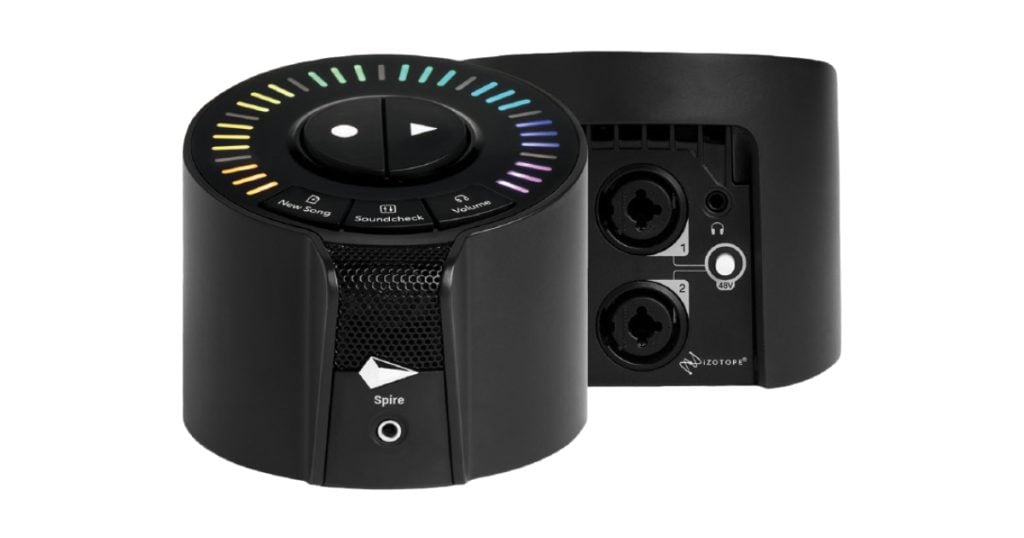Izotope Spire Studio
The growing number of performers writing songs and developing their own sound within bluegrass and elsewhere face a couple of choices when preserving those carefully nurtured songs beyond a simple smartphone video or voice memo. If you want to overdub instrumental or vocal tracks, there’re several choices, including doing your overdubs and mixing directly on your phone. You can record using your laptop and whatever DAW software and interface you prefer. Or rent studio time and work with a pro engineer. Or record your works onto a dedicated multi-track recorder where you set levels for volume and effects like the popular TASCAM DP-32 digital multitrack recorder. Each has pros and cons, naturally.
But now there’s a 21st Century option straight out of Silicon Valley. The Izotope Spire Studio combines smart speaker AI technology, along with a built-in condenser mic, to not only record your track, but to engineer and master it to what they claim is studio-quality sound. Think replacing Alexa or Siri with a top Nashville engineer/producer listening to your voice and instrument with a practiced ear, then mixing, adjusting frequency levels, adding reverb, chorus or compression, etc, to create ready-to-use tracks that sound fully mastered. At least in theory.
To accomplish this modern tech miracle, Spire syncs to your smartphone via an app. The physical controls on the unit, which is about a third the size of a Folgers can, are limited to Soundcheck, New Song, and (headphone) Volume buttons, plus physical start and stop buttons on top to control the recording. A colorful LED around the edge supplies visual feedback on volume levels and clipping, and power status. The rechargeable device uses an AC power supply, and cannot be charged by USB or connected to your laptop directly, a major drawback. On the backside, we find two Neutrik-style connectors for both XLR and 1/4” plugs, and a button to the side that controls the Spire’s phantom power, so you can plug in whatever mic you prefer.
You can easily record without even using the app or an external mic, too. Push Soundcheck, play and sing into the unit, and Spire does all its AI-based magic to create what it thinks is the best sound. Through the app, these settings can be overridden easily should you prefer more reverb, less midrange, etc. Then you push New Song, start playing, and Spire does its thing.
Oddly, Spire uses Bluetooth to communicate with your iPhone, and syncs to your wifi to communicate with the laptop. In both cases, the connection speed is often more than sluggish, especially attempting to transfer a large multi-track file over either tech. Spire clearly needs a direct USB connection to speed file transfers and make recharging simple without toting around a heavy wall wart.
The next generation Spire’s essential design upgrades also should include adding a tripod mount. When using Spire sitting on my desk, the unit over-recorded the guitar and reduced the vocals due to the proximity effect of poor mic placement on the first attempt or two. Putting it on a tripod or a mic stand would help eliminate that flaw. Once properly located, the Spire captured guitar and vocal sounds with far more depth, warmth and presence than a raw track from the Zoom H2N, with no input from the user. Using dedicated mics for an instrument or voice greatly improves the sound, as you’d expect. It’s not perfect, but the resulting sound is a reasonably close imitation of studio quality engineering, if you’re not especially picky.
Engineered for the modern working musician, the Spire Studio unit is easily portable, designed for use in a hotel room, backstage, or on the tour bus to catch those fleeting bits of creative inspiration and put a pro-level sheen on them without having to plug external gear into your computer or fire up the bulky, vintage Portastudio. You’re not likely to use the resulting tracks for much more than songwriting demos or tracks for social media distribution; it’s no replacement for studio time. Bluegrass Unlimited found the unit relatively easy to use, but it lacks any printed manual or comprehensive tutorial online, frustrating for some users. Also, on the unit we tested, the headphone volume button inexplicably failed to change the headphone volume on the playback no matter how many times or how the button was pushed. The company provides a free six-month trial subscription to its web-based Spire Pro software package, which mostly offers pre-packaged urban sounds and tips on “Recording overdubs on rap vocals.” I didn’t find much useful there for straight-up acoustic recording on it.
It’s very likely the top multitrack digital recorder companies like TASCAM and Zoom are already far into the R&D for similar AI-based units, which should include voice command and control like a smart speaker. But for now, Izotope’s Spire studio offers a unique stand-alone high-tech solution for bluegrass musicians working on original material, or who just want a playback machine as they practice or arrange songs or vocal harmonies.

